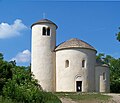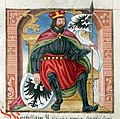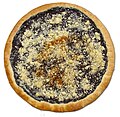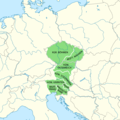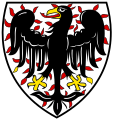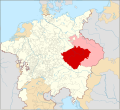Portal:Czech Republic
Welcome to the Czech Portal!
Vítejte na Českém portálu!

|

|

| |
The Czech Republic, also known as Czechia, and historically known as Bohemia, is a landlocked country in Central Europe. The country is bordered by Austria to the south, Germany to the west, Poland to the northeast, and Slovakia to the southeast. The Czech Republic has a hilly landscape that covers an area of 78,871 square kilometers (30,452 sq mi) with a mostly temperate continental and oceanic climate. The capital and largest city is Prague; other major cities and urban areas include Brno, Ostrava, Plzeň and Liberec.
The Duchy of Bohemia was founded in the late 9th century under Great Moravia. It was formally recognized as an Imperial State of the Holy Roman Empire in 1002 and became a kingdom in 1198. Following the Battle of Mohács in 1526, all of the Crown lands of Bohemia were gradually integrated into the Habsburg monarchy. Nearly a hundred years later, the Protestant Bohemian Revolt led to the Thirty Years' War. After the Battle of White Mountain, the Habsburgs consolidated their rule. With the dissolution of the Holy Roman Empire in 1806, the Crown lands became part of the Austrian Empire.
In the 19th century, the Czech lands became more industrialized; further, in 1918, most of the country became part of the First Czechoslovak Republic following the collapse of Austria-Hungary after World War I. Czechoslovakia was the only country in Central and Eastern Europe to remain a parliamentary democracy during the entirety of the interwar period. After the Munich Agreement in 1938, Nazi Germany systematically took control over the Czech lands. Czechoslovakia was restored in 1945 and three years later became an Eastern Bloc communist state following a coup d'état in 1948. Attempts to liberalize the government and economy were suppressed by a Soviet-led invasion of the country during the Prague Spring in 1968. In November 1989, the Velvet Revolution ended communist rule in the country and restored democracy. On 31 December 1992, Czechoslovakia was peacefully dissolved, with its constituent states becoming the independent states of the Czech Republic and Slovakia.
The Czech Republic is a unitary parliamentary republic and developed country with an advanced, high-income social market economy. It is a welfare state with a European social model, universal health care and free-tuition university education. It ranks 32nd in the Human Development Index. The Czech Republic is a member of the United Nations, NATO, the European Union, the OECD, the OSCE, the Council of Europe and the Visegrád Group. (Full article...)
Selected article -
The Battle of the Dukla Pass, also known as the Dukla, Carpatho–Dukla, Rzeszów–Dukla, or Dukla–Prešov offensive, was the battle for control over the Dukla Pass on the border between Poland and Slovakia on the Eastern Front of World War II between Nazi Germany and the Soviet Union in September–October 1944. It was part of the Soviet East Carpathian strategic offensive that also included the Carpathian–Uzhgorod offensive. The operation's primary goal, to provide support for the Slovak rebellion, was not achieved, but it concluded the full liberation of the Ukrainian SSR.
The German resistance in the eastern Carpathian region was much stronger than expected. The battle which began on 8 September would not see the Soviet forces on the other side of the pass until 6 October, and German forces would stop their heavy resistance in the region only around 10 October. Five days to Prešov turned into fifty days to Svidník alone with over 70,000 casualties on both sides. Prešov that was to be reached in six days remained beyond the Czechoslovaks' grasp for four months. The battle would be counted among the most bloody in the entire Eastern Front and the history of Slovakia; one of the valleys in the pass, near the villages of Kapišová, Chyrowa, Iwla and Głojsce, would become known as the "Valley of Death". (Full article...)
Selected picture

Source: Národní Galerie v Praze, PD
In this month
- 14 November 1960 – The deadliest rail disaster in Czech history takes place in Eastern Bohemia, resulting in 118 deaths
- 14 November 1918 – Tomáš Garrigue Masaryk (pictured) becomes the first President of Czechoslovakia
- 17 November 1939 – Nazi Germany storms Czech universities, executing nine students and professors, later commemorated as International Students' Day
- 17 November 1989 – The Velvet Revolution starts in Prague, culminating in the end of 41 years of Communist rule in Czechoslovakia
- 24 November 1966 – The deadliest air disaster in Czechoslovakia takes place near Bratislava, killing all 82 on board
Categories
Selected biography -
Franz Kafka (3 July 1883 – 3 June 1924) was an Austrian-Czech novelist and writer from Prague. He is widely regarded as a major figure of 20th-century literature; he wrote in German. His work fuses elements of realism and the fantastic. It typically features isolated protagonists facing bizarre or surrealistic predicaments and incomprehensible socio-bureaucratic powers. It has been interpreted as exploring themes of alienation, existential anxiety, guilt, and absurdity. His best known works include the novella The Metamorphosis and the novels The Trial and The Castle. The term Kafkaesque has entered English to describe absurd situations like those depicted in his writing.
Kafka was born into a middle-class German- and Yiddish-speaking Czech Jewish family in Prague, the capital of the Kingdom of Bohemia, which belonged to the Austrian part of the Austro-Hungarian Empire (today the capital of Czechia, also known as the Czech Republic). He trained as a lawyer, and after completing his legal education was employed full-time, for a year handling cases for the indigent in the city's Provincial and Criminal Courts by an insurance company, then working for nine months for an Italian insurance company, and finally, starting in 1908, spending 14 years with the Austrian Imperial and Royal Workmen's Accident Institute for the Kingdom of Bohemia and its successor under the Czechoslovak Republic, rising to the position of chief legal secretary. (Full article...)
Did you know?

- ...that in 1990, Czech and Slovak politicians "fought" the Hyphen War, a political battle over whether "Czechoslovakia" should be spelled with a hyphen?
- ... that in 2013, the Czech Republic plans to directly elect its president for the first time in its history?
- ... that Jan Maroši scored directly from a corner for Sigma Olomouc in a 1992–93 UEFA Cup match against Juventus?
- ... that Czech Karel Robětín was not only an Olympian and national tennis champion but also an international paper industry tycoon?
General images
Related portals
Topics

Czech lands: Bohemia • Moravia • Czech Silesia
History: Únětice culture • Boii • Marcomanni • Samo • Great Moravia • Přemyslid dynasty • Lands of the Bohemian Crown • Czech lands (1526–1648) • 1648–1867 • 1867–1918) • Czechoslovakia • Czech Republic
Geography: Lakes • Protected areas • Regions • Rivers
Law: Judiciary • Law enforcement • Supreme Court of the Czech Republic
Politics: Administrative divisions • Government • Constitution • Elections • Foreign relations • Army • Parliament • Political parties • President • Prime Minister
Economy: Banks • Czech koruna • Energy • Oil and gas deposits • Stock Exchange • Tourism • Transport
Culture: Architecture • Art • Cinema • Cuisine • Demographics • Education • Language • Literature • Media • Music • Philosophy • Prostitution • Public holidays • Religion • Sport • Television • Video games
Symbols: Flag • Coat of arms • National anthem (Kde domov můj)
Lists: Outline of the Czech Republic • List of Czech Republic–related topics
WikiProjects
Featured and good content
Things to do
Wikimedia
The following Wikimedia Foundation sister projects provide more on this subject:
-
Commons
Free media repository -
Wikibooks
Free textbooks and manuals -
Wikidata
Free knowledge base -
Wikinews
Free-content news -
Wikiquote
Collection of quotations -
Wikisource
Free-content library -
Wikiversity
Free learning tools -
Wikivoyage
Free travel guide -
Wiktionary
Dictionary and thesaurus
























